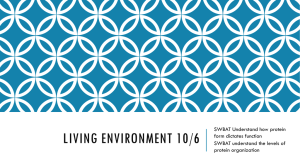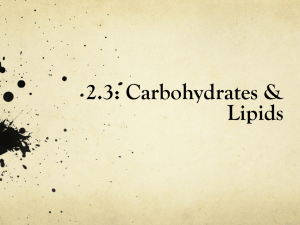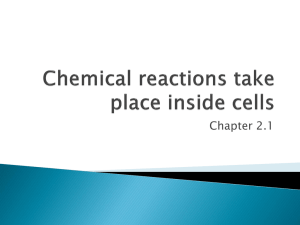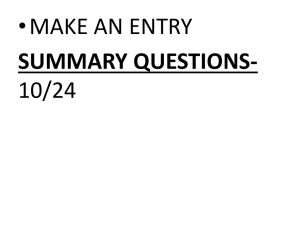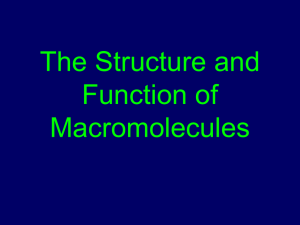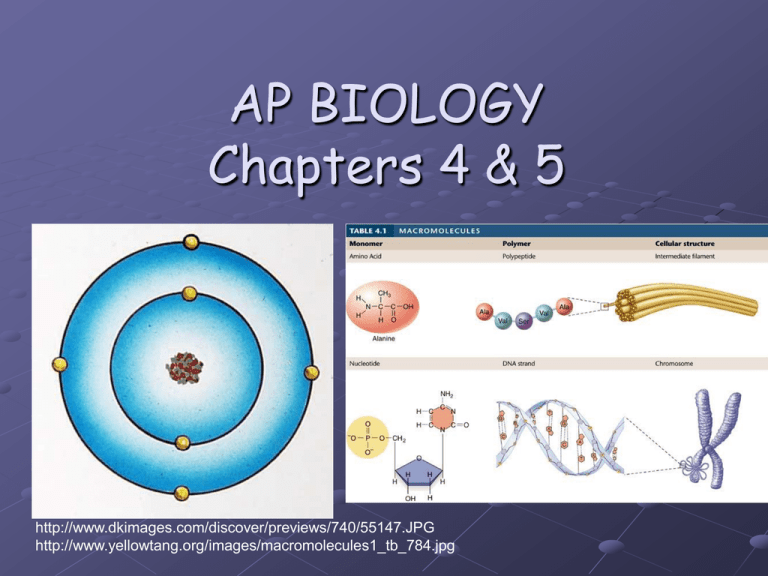
AP BIOLOGY
Chapters 4 & 5
http://www.dkimages.com/discover/previews/740/55147.JPG
http://www.yellowtang.org/images/macromolecules1_tb_784.jpg
• Identify the following functional groups
carbonyl
carboxyl
amino
Hydroxyl
(alcohol)
Images from: http://trc.ucdavis.edu/biosci10v/bis10v/week2/2webimages/Groups_5.gif
http://en.wikipedia.org/wiki/Phosphate
sulfhydryl
phosphate
• Identify the kind of molecules
aldehyde
Images from: http://www.chemcases.com/nutra/nutra1b.htm
ketone
• Identify the asymmetric carbon in the
following molecule
B is asymmetric; it has 4 different
groups attached
Campbell and Reece 7th edition
• Identify the type of geometric isomer
as TRANS or CIS
CIS
TRANS
http://www.emeraldinsight.com/fig/0170950206002.png
a phosphate
• Cells store energy by adding
________________
group to ADP
• a) Adding a phosphate group to ADP
• b) Removing a phosphate group from ATP
Compounds containing carbon are called
___________
organic
• IDENTIFY THE FUNCTIONAL GROUPS
IN THIS TRIPEPTIDE
phosphate
carbonyl
sulfhydryl
carboxyl
amino
carbonyl
hydroxyl
? Modified from Cambell and Reece; AP Biology 7th edition Chapter 4 Self quiz
• Carbon atoms are able to form bonds with
• 4___ different atoms at the same time.
The ionized form of an amino group has a
___ charge at cellular pH 7.2
positive
http://faculty.clintoncc.suny.edu/faculty/michael.gregory/files/bio%20101/bio%20101%20lectures/biochemistry/ionized%20amino%20group.gif
• Carbon is tetravalent. What does this
mean?
It can form 4 covalent bonds
• These are examples of which kind of
isomer you learned abouut?
geometric
http://www.emeraldinsight.com/fig/0170950206002.png
• Molecules that are mirror images of
each other that differ in spatial
arrangement around an asymmetric
Enantiomers
(stereoisomers)
carbon
are called
________________
How are isomers are different from isotopes?
ISOMERS are molecules with the same
molecular formula but different structures
ISOTOPES are atoms with the same number
of protons but different numbers of neutrons
• Hydrocarbons contain many Nonpolar
_________
carbon-hydrogen bonds.
•
polar
nonpolar
The ionized form of a carboxyl group has a
___ charge at cellular pH 7.2
negative
http://faculty.clintoncc.suny.edu/faculty/michael.gregory/files/bio%20101/bio%20101%20lectures/biochemistry/biochemi.htm
Chemical process that splits (lysis) water molecules
(hydro) and breaks a covalent bond as the OH- and H
groups are added back to the original monomer is called:
hydrolysis
http://www.usd116.org/apalla/biology/unit3/notes/3notes1.htm
• Chemical reaction in which two molecules
covalently bond to each other with the
removal of a water molecule
Condensation reaction (Dehydration synthesis)
Name the four main classes of
biological macromolecules
Proteins, lipids, carbohydrates, nucleic acids
• The simplest sugars are called
•monosaccharides
________________
GLYCOGEN
_____________
is the highly branched
polysaccharide used by animal cells to
store glucose. Also called animal starch
NONPOLAR molecules
Lipids are____________
polar nonpolar
Chemical process that splits molecules
by the addition of water.
hydrolysis
http://www.usd116.org/apalla/biology/unit3/notes/3notes1.htm
• Molecules made of two monosaccharides
• are calleddissaccharides
______________
The subunits joined to make proteins
amino acids
are _______________
The major polysaccharide component
found in plant cell walls is
_____________________
cellulose
• Use the correct numbering sequence to
identify the number of this carbon
6
5
4
1
3
2
• Carbohydrates made from joining many
sugar molecules together are called
polysaccharides
• ____________________
Glucose and fructose can be joined to make
dehydration synthesis
sucrose via a ___________________
reaction.
• The two interconvertible forms of
glucose differ in the placement of the
hydroxyl group attached to the #1
carbon.
• Label the two forms as α (alpha) or ß
(beta)
BETA
Hydroxyl is up
ALPHA
Hydroxyl is down
http://www.elmhurst.edu/~chm/vchembook/images/543Halphabetaglucose.gif
• Amylose and amylopectin are both forms of
starch
_____________
How are these different?
Amylose is unbranched and joined only
by α 1,4 linkages
Amylopectin is branched with 1,6 linkages
at the branch points
• How are starch and cellulose different?
Starch is made up of glucose rings in the
α (alpha) form joined by 1,4 linkages;
helical; can be branched; humans can
digest this
Cellulose is made up of glucose rings in the
ß (beta) form so every other glucose is
upside down the respect to its neighbors;
joined with 1,4 linkages; straight-never
branched; hydrogen bonds join parallel
molecules into microfibrils; humans can’t
digest this
• A structural polysaccharide of plant cell
walls, consisting of glucose monomers
joined by β-1, 4-glycosidic linkages.
cellulose
Where is chitin found in nature?
Cell walls of fungi;
exoskeletons of arthropods
• Which type of bonds hold the parallel
cellulose strands together?
Hydrogen bonds hold about 80 cellulose
molecules together to make a microfibril
Image modified from: Campbell and Reece; AP Biology 7th edition
Image modified from: http://www.yskf.jp/yskf_en/img_03/03_01.gif
• This subunit is
N-acetylglucosamine
_________________
(NAG)
It can be joined together in long chains by
chitin
ß 1,4 linkages to make _________
• Which kind of fatty acids have kinks in
their shape so that they don’t pack closely
together- saturated or unsaturated?
unsaturated
Another name for a triacylglycerol molecule
fat
• What kind of bond is a disulfide
bridge?
•
ionic
covalent
hydrogen
covalent
A fatty acid possessing one or more double
bonds between carbons in the hydrocarbon
unsaturated
tail is called _______________
• Which type of bonds hold the parallel
cellulose strands together?
Hydrogen bonds
A fatty acid in which all carbons in the
hydrocarbon tail are connected by single
saturated
bonds is called _______________
• The subunit used to make starch,
glucoseis __________
cellulose, and glycogen
The sequence of aminoo acids in a protein
Primary 1 structure
is called the ________
• The polysaccharide made up of glucose
subunits with a nitrogen containing group
attached which is used to build the
exoskeletons of arthropods is called
chitin
_______________
A fat is made up of one ________
glycerol molecule
and three ___________
fatty acid
molecules.
• Amino acid molecules used by living things are
L
• usually the ___
stereoisomer version.
•
L
or
The covalent bond
that joins sugar
molecules to make
a polysaccharide is
called a
glycosidic bond.
_________
D
• The alpha helix coiling and beta pleated
sheet shapes seen
in proteins is called
o
2
the Secondary
_____________
structure.
Which kinds of bond holds these together?
Hydrogen bonds between the C=O of
one amino acid and the N-H of another
• The addition of smaller similar subuints
to build a large repeating molecule is
called
polymerization
The subunits are called
monomers
___________
and the
molecule that is formed is
polymer
called a ______________
Image by K.Riedell
• Sugar molecules used by living things
D
are
• usually the ___ stereoisomer version.
•
L
or
D
The structural polysaccharide found
in plant cell walls that provides support
cellulose
is ____________
Chaparonins
• _____________
are molecules that
help proteins fold up into their correct
3D
• shape by shielding them from the
cytoplasmic environment.
Image from: AP BIOLOGY by Campbell and Reese 7th ed.
• Sugars with 6 carbons are called
• hexoses
_______________
Sucrose is made by joining which 2 sugars?
Glucose + fructose = sucrose
• Sugars made from 2 sugar monomers
are calleddisaccharides
__________________
Name one of the polysaccharides
you learned about.
Glycogen, starch, cellulose, chitin
The kind of covalent bond that joins
amino acids together is called
peptide bond
a _________
http://www.chemicalconnection.org.uk/chemistry/topics/images/pp3.jpg
• Unsaturated fats and fatty acids are
liquid
_________
at room temperature.
•
solid
liquid
http://io.uwinnipeg.ca/~simmons/cm1503/lipids.htm
• The folding of a protein molecule into
its 3D shape due to the interactions of
R side chains involved hydrophobic
interactions, ionic bonds, hydrogen
bonds, an disulfide
bridges
result
in
its
o
Tertiary 3
___________
structure.
http://www.odec.ca/projects/2004/thog4n0/public_html/fatyacid.jpg
• Tell the kind of
macromolecule you learned
about that could be built
from these subunits
Fat (triacylglycerol)
http://www.odec.ca/projects/2004/thog4n0/public_html/chemfat.html
• This isomer of glucose
• in which the -OH on C1
hangs down below the
plane of the ring is called
• _____ glucose
α
Name a polysaccharide that this form of
glucose could be used to make
Starch (amylose or amylopectin) or glycogen
• The association of multiple protein chains
o
Quaternary 4
together results in its _____________
http://www.bio.miami.edu/~cmallery/150/chemistry/hemoglobin.jpg
• Saturated fats and fatty acids are
solid
_________
at room temperature.
•
solid
liquid
http://io.uwinnipeg.ca/~simmons/cm1503/lipids.htm
• This isomer of glucose
• in which the -OH on C1
sticks up above the plane
of the ring is called
• _____ glucose
ß
Name a polysaccharide that this form of
glucose could be used to make
Cellulose or chitin (if nitrogen group added)
• Name this type of
• Lipid characterized
• by a carbon
skeleton
• consisting of 4
rings
• with various
steroids
• functional groups
• Sugar molecules with 6 carbons are
called hexoses
________
Which nitrogen base is not found in RNA?
thymine
Name this steroid
from which other
steroids including
human sex
hormones
• are synthesized.
•
•
•
•
cholesterol
Which part of a phospholipid is polar?
Glycerol-phosphate head
http://z.hubpages.com/u/105829_f520.jpg
A diet high in
saturated
____________
fats is one of
the factors that
can contribute
to cardiovascular
disease.
• saturated unsaturated
• CONTRAST: GLYCOGEN and STARCH
Differences:
Glycogen
Starch
Highly branched
amylose (unbranched)
amylopectin
(less branched than glycogen)
Made by animals
made by plants
α 1,4 & 1,6
• Which part of a phospholipid molecule is
non-polar?
Fatty acid tails
ENZYMES are proteins that act
__________
as catalysts to speed up
chemical reactions in living things
• How many fatty acid tails are found in a
phospholipid? 2
Fatty acid molecules consist of long
hydrocarbon chains with which functional
group attached at one end?
carboxyl
http://www.odec.ca/projects/2004/thog4n0/public_html/fatyacid.jpg
• COMPARE GLYCOGEN and STARCH
Alike:
Made of α –glucose subunits
α 1,4 linkages
1,6 linkages @ branch points
Glycosidic bonds
Glucose polymers
Ways to store glucose
Digestible by humans
• Which of the four biomolecule groups you
learned is hydrophobic?
lipids
Another name for a fat is
triacylglycerol
____________________
• Which of these structures would NOT
• be found in a DNA molecule?
A (ribose)
and D (uracil)
Image from LearningExpress.com
• Dehydration synthesis is also called
•condensation
____________ reaction.
Which nitrogen base is not found in DNA?
uracil
• The addition of a phosphate group to ADP
• stores
____________ energy.
•
stores
releases
Organic chemistry is the branch of chemistry
carbon
that studies molecules that contain _______
• The removal of a phosphate group from
releases
ATP to form ADP____________
energy.
•
stores
releases
TRUE or FALSE
L and D stereoisomers have the same
chemical properties because they contain
the same number and kinds of atoms
TRUE or FALSE
L and D stereoisomers have the same
chemical properties because they contain
the same number and kinds of atoms
FALSE
L and D enantiomers can have very different
chemical properties.
Ex: L-Dopa is a drug used to treat Parkinson’s disease, but D-Dopa has
no effect on patients.
Thalidomide- one enantiomer of used to treat morning
sickness; other form caused birth defects
• Name the structural polysaccharide
found in the cell walls of plants that
provides support
cellulose
Polymers of amino acids are called
polypeptides
______________
• Chemical bond in which atoms share
• 2 pairs of electrons
Covalent double bond
• List some functions of fat
Energy storage
(1 g of fat has more than twice as much energy as
1 g of polysaccharide)
Cushions vital organs
Insulates body against heat loss (blubber)
• List some functions of nucleic acids
Store genetic information
Protein synthesis
Nucleotide subunits:
ATP: store and transport energy
NAD+
NADP+
FAD
Coenzyme A
energy/electron carriers
• Which form of glucose is used to build
cellulose molecules?
ß-glucose
The “kinks” in fatty acids are due to
cis-double bonds
_____________________
• Which chemical reaction joins glycerol
and fatty acids to make a fat?
Dehydration synthesis or condensation
The place on an enzyme where the
substrate attaches is called the
Active site
_______________
• The reactant in an enzyme catalyzed
substrate
reaction is called a _____________
Name the amino acid that can form
disulfide bridges
Cysteine
• Which functional group is responsible
for the formation of disulfide bridges?
-SH sulfhydryl
The unwinding and loss of conformation
denaturing
in proteins is called _____________
• Which is the only amino acid without an
asymmetric carbon?
GLYCINE
It has an –H
for its R group
http://upload.wikimedia.org/wikipedia/commons/0/07/Glycine2.png
• Name an environmental factor that can
cause proteins to denature
pH extremes
Salt concentration
Temperature (heat)
TRUE or FALSE
Denaturing in proteins is due to the
disruption of peptide bonds
False; 1° remains intact but hydrogen bonds, ionic bonds and
disulfide bridges in 2° & 3°are disrupted
• Which amino acid is involved in making disulfide
bridges to form the tertiary structure of
proteins?
•
cysteine
-SH (sulfhydryl) group forms disulfide bridges
http://upload.wikimedia.org/wikipedia/commons/5/5e/L-Cysteine.png
http://www.mun.ca/biology/scarr/Disulfide_bridge.htm
• COMPARE and CONTRAST:
• DNA
RNA
Double stranded
Contain A, T, C, G
No uracil
Deoxyribose
Store genetic info
Single stranded
Contain A, U, C, G
No thymine
Ribose
Carry info from DNA to cell
Protein synthesis
BOTH:
Nucleic acids, made of nucleotide subunits, are polymers,
Information molecules, joined using dehydration synthesis,
Contain pentose sugars and nitrogen bases,
have phosphate-sugar backbones,
• Nitrogenous bases consisting of 2 rings
purines
are called _______________
The two sugar-phosphate backbones in
a DNA molecule run in opposite directions,
an arrangement referred to as
antiparallel
___________________
• Nitrogenous bases consisting of 1 ring
pyrimidines
are called _______________
Name the subunit used to build nucleic
acids which consists of a pentose sugar,
nitrogen base, and a phosphate group.
nucleotide
The nitrogen bases that join by
hydrogen bonds to form the stair steps
of the DNA ladder always pair up so that
a pyrimidine-a purine match up with each
_________________
other.
two purines
two pyrimidines
a pyrimidine-a purine
• Give an example of a pyrimidine
Cytosine (C), Thymine (T) and Uracil (U)
In a DNA molecule guanine always pairs up
cytosine
with _____________
• Which of these structures would NOT
• be found in an RNA molecule?
C (deoxyribose)
and F (thymine)
Image from LearningExpress.com
• Carbohydrates that contain 5 carbon
trioses
atoms are called _____________
Which carbon is important in determining
whether a glucose molecule is in the
α or ß form?
C1
• In a DNA molecule adenine always pairs
• withthymine
_____________
A pentose sugar with only the nitrogen base
nucleoside
attached is called a _____________
• Molecules with both polar and nonpolar
amphipathic
parts are called _______________
Molecules containing only hydrogen and
hydrocarbons
carbon are called ________________
• Compare and contrast phospholipids and
triglycerides (fat)
• BOTH
Glycerol backbone
Multiple phobic fatty acid chains attached
By ester linkages
• PHOSPHOLIPIDS
TRIGLYCERIDES
2 fatty acid chains
3 fatty acid chains
phosphate group
nonpolar
Amphipathic
(polar head; nonpolar tails)
• Which two amino acids contain SULFUR ?
Cysteine
methionine
Look at these structures. Why can’t methionine form
disulfide bridges?
No –SH group; it’s got a methyl group
http://upload.wikimedia.org/wikipedia/commons/5/5e/L-Cysteine.png
http://upload.wikimedia.org/wikipedia/commons/6/64/L-Methionine.png
• Tell the central dogma of molecular
biology
• that describes how information flows
• in eukaryotic cells
DNA →RNA → proteins
Write the chemical formula for a
monosaccharide with 3 carbons
C3H6O3
• What disaccharide does it make?
• Glucose + glucose =maltose
______________
sucrose
• Glucose + fructose = ____________
lactose
• Glucose + galactose = ______________
http://altopower.files.wordpress.com/2008/04/sugar.jpg
• Table sugar is called
sucrose
____________
Which parts of a nucleotide form the
backbone of a nucleic acid?
Sugar and phosphate
• Put the following in order from least to
most branched…
•
• Glycogen
amylose
amylopectin
amylose
amylopectin glycogen
Saturated
• ___________ fats are more common in
• animals than plants.
TRUE or FALSE
Amino acids be enantiomers
True; the center carbon is attached to 4
different groups; there are D and L forms
of all amino acids except glycine
https://sharepoint.cisat.jmu.edu/isat/klevicca/Web/NMR_2002/glycine/Glycine2.gif
• Name the only amino acid of the 20
amino acids used to make proteins that
doesn’t have a stereoisomer
(enantiomer) GLYCINE
It does NOT
have a chiral
carbon; it does
not have 4
different groups
attached
•
•
•
•
•
Amylase is an enzyme that can break
glyosidic linkages between α-glucose monomers.
Which of the following could amylase
break down?
cellulose
glycogen
amylopectin
starch
chitin
Glycogen, amylopectin, starch
? From AP BIOLOGY by Campbell and Reese 7th edition Chapter 5 self quiz





